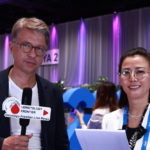
Editor's Note: Traditional treatment for head and neck tumors mainly involves surgery, radiotherapy, and chemotherapy. In recent years, immune checkpoint inhibitors have shown promising potential in treating head and neck squamous cell carcinoma, and new radiotherapy techniques such as proton and carbon ion therapy offer treatment options with reduced radiation toxicity for patients with head and neck tumors. At the recent 2024 BOC/BOA conference, Professor Chaosu Hu from Fudan University Shanghai Cancer Center chaired the head and neck tumor session, sharing and discussing significant research findings from the 2024 ASCO conference with colleagues. Oncology Frontier interviewed Professor Hu at the BOC/BOA conference to further explore the current diagnosis and treatment status and research progress in head and neck tumors.Challenges in Treating Head and Neck Tumors
Oncology Frontier: As one of the common malignant tumors in China, head and neck tumors are diverse. What do you think are the main challenges in treating head and neck tumors?
Professor Chaosu Hu: Head and neck tumors are among the common malignant tumors in China. Due to their unique locations, they involve functions such as speech, swallowing, and breathing, which are basic physiological functions. Tumor-induced disability in these areas can severely affect a patient’s quality of life and even survival. Therefore, when treating head and neck tumors, we must consider both the efficacy and the patient’s quality of life, as both are equally important.
The treatment of head and neck tumors varies according to different anatomical locations, pathological types, and tumor stages, and the treatment outcomes are still unsatisfactory. Especially in China, a high proportion of patients are diagnosed at intermediate to advanced stages, leading to an overall five-year survival rate of less than 50%. Head and neck tumors include nasopharyngeal carcinoma, thyroid cancer, laryngeal cancer, oropharyngeal and tonsillar cancer, among others, with nasopharyngeal carcinoma having relatively better treatment outcomes. However, the treatment methods for different head and neck tumors need further refinement. Traditional broad treatment modes, such as radiotherapy and chemotherapy, still pose a high risk of recurrence or metastasis for many patients.
Therefore, while improving survival rates, we must also strive to enhance the quality of life for patients. There is still much room for improvement in this area.
Value of Immunotherapy and Traditional Treatments for Advanced Head and Neck Squamous Cell Carcinoma
Oncology Frontier: About 90% of head and neck tumors are squamous cell carcinomas, and the prognosis for intermediate to advanced patients is poor. In recent years, immunotherapy has opened new avenues for the treatment of advanced head and neck squamous cell carcinoma. How do you view the value of immunotherapy and traditional treatments such as radiotherapy for head and neck squamous cell carcinoma?
Professor Chaosu Hu: Traditional treatment methods for head and neck tumors include surgery, radiotherapy, and chemotherapy. In recent years, targeted therapy and immunotherapy have also been added. I believe a significant feature of head and neck tumor treatment is comprehensive treatment. Multidisciplinary comprehensive decision-making can provide patients with the best treatment plan, maximizing the benefits.
Although immunotherapy has seen substantial development in recent years, several large clinical studies in head and neck squamous cell carcinoma have shown that adding immunotherapy to concurrent radiotherapy and chemotherapy has not achieved very good results. However, the phase II PATHWay study (Abstract 6008) reported at this year’s ASCO meeting showed that pembrolizumab adjuvant immunotherapy achieved better PFS benefits in high-risk locally advanced head and neck squamous cell carcinoma patients. In fact, many small-sample clinical studies in China have shown good pCR rates for neoadjuvant immunotherapy in head and neck squamous cell carcinoma. However, whether these can translate into long-term survival benefits still requires further long-term follow-up or larger-scale clinical studies for verification, which I think is very important.
Radiotherapy plays a critical role in the treatment of head and neck tumors. From conventional fractionated radiotherapy to three-dimensional conformal radiotherapy, intensity-modulated radiotherapy, and new radiotherapy technologies like proton and carbon ion therapy, the precision of radiotherapy has greatly improved, significantly reducing radiation toxicity and improving patients’ quality of life. Therefore, I think it is still too early to abandon radiotherapy. Our radiotherapy technology and equipment are developing, and they play a significant role in improving efficacy and quality of life. How to better combine various treatment methods, including chemotherapy, immunotherapy, and surgery, is an important research direction in the future.
Future Impact of Immunotherapy on Clinical Guidelines
Oncology Frontier: The progress in immunotherapy was a major discussion point in the head and neck tumor field at this BOC/BOA conference. Do you think immunotherapy will be able to rewrite clinical guidelines in the future?
Professor Chaosu Hu: In fact, immunotherapy is now being widely used. As I mentioned earlier, several clinical studies have not been successful in adding immunotherapy to concurrent radiotherapy and chemotherapy for locally advanced head and neck squamous cell carcinoma. However, many neoadjuvant treatment studies in China, combining neoadjuvant chemotherapy with immunotherapy, have achieved good pCR rates. This is a positive result, but these studies have small sample sizes, and we may need to conduct large-scale phase III clinical studies together for further validation.
Additionally, the PATHWay study reported at this ASCO conference, a phase II study with a sample size of 100 cases, also needs further larger studies for validation. Overall, accurately identifying the population that benefits most and exploring better treatment models are issues that need further exploration in the immunotherapy of head and neck tumors. Some exploratory or proof-of-concept studies are attempting to change radiotherapy techniques, fractionation doses, and irradiation ranges to better synergize radiotherapy and immunotherapy, thereby reducing treatment toxicity. We look forward to more efficient and safe immunotherapy or combination therapy regimens in the future that can truly change clinical practice and rewrite guidelines.
Value of New Radiotherapy Technologies: IMRT and Proton Carbon Ion Therapy
Oncology Frontier: Intensity-modulated radiotherapy (IMRT) and proton carbon ion therapy are new radiotherapy technologies that have rapidly developed in recent years and have been extensively explored in head and neck tumors. How do you view the application value of these new radiotherapy technologies?
Professor Chaosu Hu: Proton and carbon ion therapy represent a significant advancement in radiotherapy. Conventional radiotherapy uses photon radiation, such as X-rays and gamma rays, which have relatively low energy. In contrast, proton or carbon ion therapy uses particle radiation, which can form an energy Bragg peak, providing stronger tumor cell killing effects and better protection for normal tissues. Additionally, various intensity-modulated technologies can more precisely adjust radiation doses, also enhancing radiotherapy efficacy and reducing toxicity.
A large phase III clinical trial from the United States (Abstract 6006) reported at the 2024 ASCO conference compared the efficacy and safety of intensity-modulated proton therapy (IMPT) with intensity-modulated photon therapy (IMRT) in treating stage III-IV head and neck oropharyngeal cancer (OPC). The results showed non-inferior PFS, a trend toward improved overall survival, better safety, and quality of life with IMPT, and reduced dependence on feeding tubes and malnutrition occurrences.
Proton and carbon ion therapy indeed have certain advantages, and these new radiotherapy technologies are rapidly developing in China. For certain tumors, such as chordomas, adenoid cystic carcinomas, chondrosarcomas, or salivary gland cancers, proton therapy may be more effective than photon therapy. Additionally, proton and carbon ion therapy can reduce the incidence of adverse events like tube feeding dependence and malnutrition, improve quality of life, and reduce the occurrence of second primary tumors caused by traditional radiotherapy. These long-term effects are particularly significant for adolescent patients who are still in growth and development stages.
However, as proton and carbon ion therapy rapidly develop in China, we also need to consider cost issues and which patients are more suitable for this treatment method. I also believe that quality control in radiotherapy is very important. As we introduce new technologies, we need to improve quality control standards and requirements to ensure that patients receive standardized and reasonable treatment. Additionally, we need to better understand the radiobiological characteristics of proton and carbon ion therapy to further improve the efficacy and safety of these new radiotherapy technologies and explore more optimized treatment models.
Professor Chaosu Hu
- Chief Physician, Professor, Doctoral Supervisor at Fudan University Cancer Hospital
- Director of the Nasopharyngeal Carcinoma Diagnosis and Treatment Center, Chief Expert on Nasopharyngeal Carcinoma at Fudan University
- Former Chairman of the Nasopharyngeal Carcinoma Committee of the Chinese Anti-Cancer Association
- Former Chairman of the Radiotherapy Oncology Committee of the Shanghai Medical Association
- Chairman of the Nasopharyngeal Carcinoma Quality Control Expert Committee of the National Cancer Center
- Vice Chairman of the Nasopharyngeal Carcinoma Committee of the Chinese Society of Clinical Oncology
- Vice Chairman of the Head and Neck Tumor Committee of the Chinese Society of Clinical Oncology
- Standing Committee Member of the Neuro-Oncology Committee of the Chinese Anti-Cancer Association
- Standing Committee Member of the Radiotherapy Oncology Committee of the Chinese Anti-Cancer Association
- Chairman of the Nasopharyngeal Carcinoma Committee of the Shanghai Anti-Cancer Association
- Completed advanced training in radiotherapy at William Beaumont Hospital, USA, in 1994 and MD Anderson Cancer Center, USA, in 2004
- Specializes in radiotherapy and comprehensive treatment of nasopharyngeal carcinoma and head and neck tumors
- Received major project funding from the Shanghai Municipal Science and Technology Commission and the Ministry of


